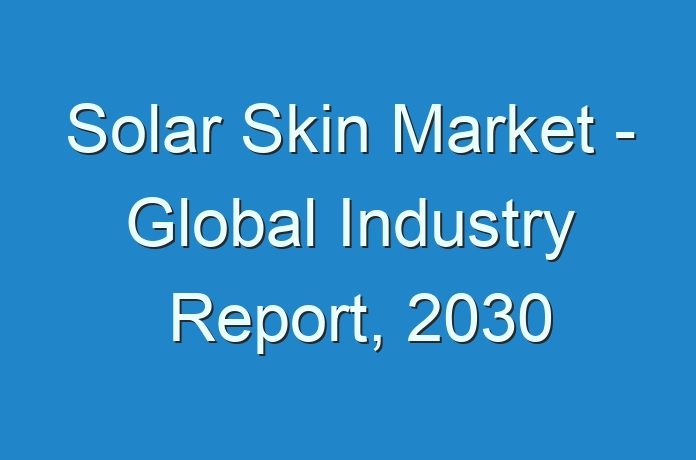
Solar Skin: Introduction
- Solar skin can be considered an esthetic modernization of solar panels. Solar skin can make the panel suitable for usage in roofs of various patterns, colors, or styles in residential and commercial buildings.
- Solar skin uses selective light filtration that allows simultaneous display of a vibrant image. It transmits sunlight toward the underlying solar panel with minimal loss in efficiency.
- Solar panels with solar skins can achieve efficiency rates of about 15% to 17%, which is considered equal or even a little better than the average commercially available panel
- Solar skin can be used on bus windows, as it allows light to filter through the solar skin to photovoltaic cells beneath it
Are you a start-up willing to make it big in the business? Grab an exclusive PDF Brochure of this report
Key Drivers of Global Solar Skin Market
- Rise in transition toward renewable energy is likely to offer significant opportunities to lease providers due to the long-term benefits of solar energy. This is expected to drive the global market for solar skin during the forecast period.
- Government subsidies for solar power across the world can be leveraged by solar skin manufacturers. This is anticipated to offer considerable opportunities to the global solar skin market during the forecast period.
- According to the Department of Energy in the U.S., almost 13 million homes across the country do not adopt solar energy, as they do not like the look of the panels. Solar skin would eventually encourage home owners to install solar panels. This is expected to drive the solar skin market.
To gauge the scope of customization in our reports, Ask for a Sample
Restraints of Global Solar Skin Market
- Solar skin panels usually add about 10% to the total cost of a solar system. This is one of the major restraints of the global solar skin market. However, it is a small price to pay for people who find panels to be unattractive, but still want the financial and environmental benefits of solar panels.
Major Developments
- In October 2019, Energy Foundry, a Chicago-based venture fund that invests in early-stage energy and clean-tech startups, announced that it had invested US$ 3.2 Mn in Sistine Solar, which is scaling up deployment of its SolarSkin product. Energy Foundry, Massachusetts Clean Energy Center (MassCEC), and Thin Line Capital join are currently angel investors in this round.
- In March 2018, Sistine Solar, the maker of SolarSkin, launched the SolarSkin Design Studio, an online platform that allows homeowners to customize the look and feel of their solar installations using the Department of Energy-backed solar panel-attached graphics. Homeowners can design solar panels that blend in with their existing roofs, whether those roofs are made of green architectural shingles, red Spanish tiles, or any other material.
More Trending Reports by Transparency Market Research – https://www.prnewswire.com/news-releases/oil–gas-epc-market-to-reach-a-valuation-of-us-64-7-bn-by-2027-growth-in-ep-in-oil-and-gas-industry-boosting-growth-states-transparency-market-research-301005816.html
COVID-19 Impact Analysis
- The global economy has been hampered by the measures put in place to contain the COVID-19 pandemic. The solar industry is estimated to face immediate challenges due to the COVID-19 pandemic such as difficulty in adhering to the social distancing norms, shortage of manpower, lack of parts & equipment, and discerning expenditure by end-users.
- Currently, the solar industry imports almost 80% of all of its equipment and parts in the value chain from China. The COVID-19 pandemic has adversely affected the manufacturing capacities of China. Most of the ship container companies have stopped functioning out of Chinese ports. Major economies such as India have stopped transportation of goods from China.
Europe to Hold Major Share of Global Solar Skin Market
- Based on region, the global solar skin market can be classified into North America, Asia Pacific, Europe, Latin America, and Middle East & Africa
- Europe is likely to dominate the global solar skin market during the forecast period. High investments, especially by governments of countries such as Germany, and technological advancements are projected to drive the market in the region from 2024 to 2030.
- The European Union (EU) aims to achieve 20% share of energy from renewable energy sources (RESs) in the final energy consumption by the end of 2024. This is expected to drive the market in the region during the forecast period.
- On the other hand, the size of the renewable energy industry in the U.S. in North America is anticipated to double by the end of the forecast period. Renewable energy projects in the country are likely to benefit from multi-year federal tax incentives and several state-level policies that promote the use of solar energy in the next few years.
- Asia Pacific is projected to offer significant opportunities to the global solar skin market during the forecast period, due to rise concerns about air pollution and carbon emissions in India and China. Additionally, government tariff and policies promoting the use of solar technology are expected to propel the solar skin market in Asia Pacific.
Key Players Operating in Global Market
Sistine Solar is the key player operating in the global solar skin market. Companies that use solar panels equipped with Sistine Solar’s solar skins include:
- LG Electronics
- Solaria Corporation
- Canadian Solar
- Trina Solar
- Q CELLS
- SunPower Corporation
Global Solar Skin Market, Research Scope
Global Solar Skin Market, by Type
- Photovoltaic Films
- Dual Glass
- Solae Embedded Windows
Global Solar Skin Market, by Application
- Residential
- Commercial
- Industrial
- Others
Request for covid19 Impact Analysis – https://www.transparencymarketresearch.com/sample/sample.php?flag=covid19&rep_id=78376





